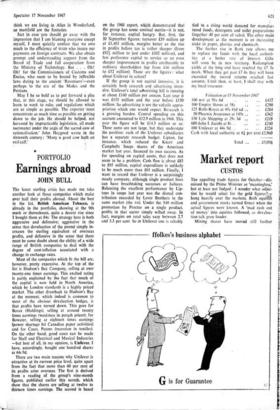Earnings abroad
PORTFOLIO JOHN BULL
The latest sterling crisis has made me take another look at those companies which make over half their profits abroad. About the best in the list, British American Tobacco, is already in the portfolio, showing at the 90s mark or thereabouts, quite a decent rise since I bought them at 84s. The strategy here is both aggressive and defensive; aggressive in the sense that devaluation of the pound simply in- creases the sterling equivalent of overseas profits, and defensive in the sense that there must be some doubt about the ability of a wide range of British companies to deal with the degree of cost-inflation associated with a change in exchange rates.
Most of the companies which fit the bill are, however, pretty expensive. At the top of the list is Hudson's Bay Company, selling at over twenty-one times earnings. This exalted rating is partly explained by the fact that much of the capital is now held in North America, which by London standards is a highly priced market. The other drawback to Hudson's Bay at the moment, which indeed is common to most of the obvious devaluation hedges, is that profits have turned down. This goes for Borax (Holdings), selling at around twenty times earnings (weakness in potash prices); for Bowater, selling at eighteen times earnings (power shortage hit Canadian paper activities) and for Coats, Patons (recession in textiles). On the other hand, good cases can be made for Shell and Electrical and Musical Industries —but best of all, in my opinion, is Unilever. I have, accordingly, bought one hundred shares at 44s 9d.
There are two main reasons why Unilever is attractive at its current price level, quite apart from the fact that more than 60 per cent of its profits arise overseas. The first is derived from a reading of the group's nine-month figures, published earlier this month, which show that the shares are selling at twelve to thirteen times earnings. The second is based on the 1966 report, which demonstrated that the group has some undual merits—it is not, for instance, capital hungry. But, first, the 30 September figures: turnover £59 million up at £1,483 million, margins better so the rise in profits before tax is rather sharper (from f921 million to just under £102 million), and less preference capital to service so an even sharper improvement in profits attributable to ordinary shareholders (up from £46 million to £52 million). Those are the figures : what about Unilever in action?
If the group is not capital intensive, it is certainly both research and advertising inten- sive. Unilever's total ackertising bill is running at about £160 million per annum. Last year it was £155 million and the year before £150 million. So advertising is not the volatile appro- priation which one would expect. Research is a growing burden. Central spending on this account amounted to £12.9 million in 1966. This year the figure will be £14.5 million or so. These sums are not large, but they understate the position: each of the Unilever subsidiaries has a separate research budget. Lipton, for instance, which reduced the Knorr and Campbells Soups shares of the American market last year, financed its own success. As for spending on capita! assets, that does not seem to be a problem. Cash flow is about £85 to £95 million, capital expenditure is unlikely to be much more than £65 million. Finally, I want to record that Unilever is a surprisingly steady company, although single product lines can have breathtaking successes or failures. Balancing the excellent performance by Lip- tons in soups last year was the dismal con- tribution recorded by Lever Brothers in the same market (the us). Under the $40 million promotion by Proctor on a single product, profits in that sector simply wilted away. In fact, margins on total sales vary between 2.7 and 3.3 per cent. So in Unilever one is reliably
• tied to a rising world demand for manufac- tured foods, detergents and toilet preparations (together 40 per cent of sales). The other main development at the moment is an increasing stake in paper, plastics and chemicals.
The further rise in Bank rate allows me to replace my funds with the local authori- ties at a better rate of interest. Gilts will soon be in new territory. Redemption yields at the long end have reached the £7 3s mark. When they get past £7 6s they will have exceeded the record returns reached last autumn. Until then, at least,T shall stay with my local treasurer.
Valuation at 15 November 1967
100 BAT at 91s 64
£457 100 Empire Stores at 58s • • £290 125 Rolls-Royce at 45s 444 xd
£284 50 Phoenix Assurance at 145s .. £362 150 Lyle Shipping at 29s 3d
£219 600 John I. Jacobs at 8s ..
£240 100 Unilever at 44s 9d ..
£224 Cash with local authority at 61 per vent £2,960 Total .. £5,036


































 Previous page
Previous page